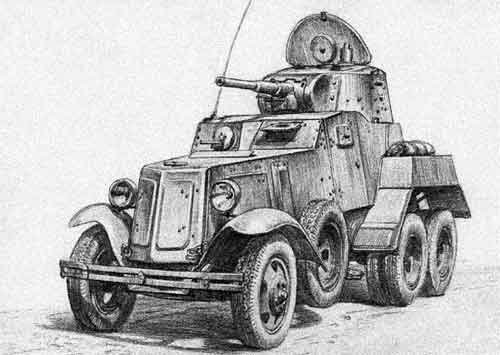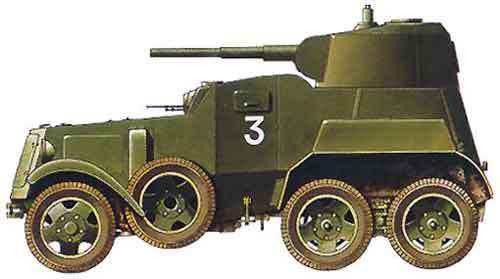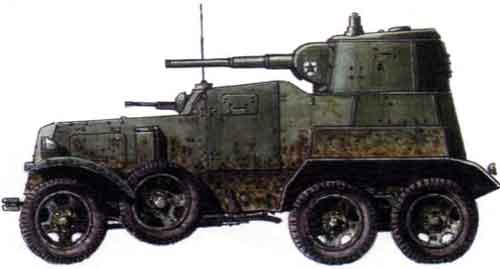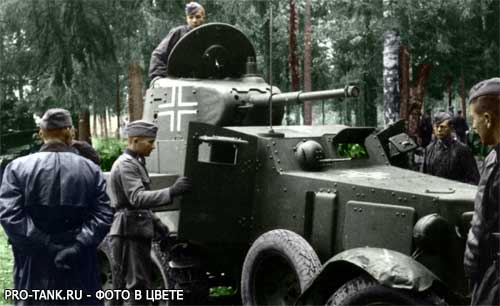
Medium armored car BA-10
Content
Medium armored car BA-10
Telescopic and periscopic sights were used to control the fire from the cannon. The armored car had good driving performance: it overcame slopes up to 24 degrees and crossed water barriers up to 0,6 m deep. To improve patency, track belts of the “Overall” type could be put on the rear wheels. At the same time, the armored car became half-tracked. In 1939, the armored car underwent modernization, during which the steering was improved, the radiator protection was strengthened, and a new radio station 71-TK-1 was installed. This version of the armored car was named BA-10M. In 1938, the Red Army adopted the BA-10 medium armored car, developed in 1937 at the Izhora plant by a group of designers headed by well-known specialists - A. A. Lipgart, O. V. Dybov and V. A. Grachev. BA-10 was a further development of the line of armored vehicles BA-3, BA-6, BA-9. It was mass-produced from 1938 to 1941. In total, during this period, the Izhora plant produced 3311 armored vehicles of this type. The BA-10 remained in service until 1943. The basis for the BA-10 armored vehicle was the chassis of a three-axle truck GAZ-AAA with a shortened frame: 200 mm was cut out of its middle part and the rear part was reduced by another 400 mm. The armored car was made according to the classic layout with a front engine, front control wheels and two rear drive axles. The BA-10 crew consisted of 4 people: commander, driver, gunner and machine gunner.
The fully enclosed riveted-welded hull of the armored vehicle was made of rolled steel sheets of various thicknesses, which were installed everywhere with rational angles of inclination, which increased the bullet resistance of the armor and, accordingly, the degree of crew protection. For the manufacture of the roof were used: 6 mm bottoms - 4 mm armor plates. The side armor of the hull had a thickness of 8-9 mm, the frontal parts of the hull and turret were made of armor sheets 10 mm thick. The fuel tanks were protected by additional armor plates. For landing the crew in the car on the sides of the middle part of the hull there were rectangular doors with small windows equipped with armored covers with viewing slots. For hanging doors, internal hinges were used instead of external ones, which saved the outer surface of the case from unnecessary small parts. On the left in the control compartment, located behind the engine compartment, there was a driver's seat, on the right - an arrow serving a 7,62-mm DT machine gun mounted in a ball mount in a beveled frontal hull plate. The driver's view was provided by a windshield equipped with a hinged armored cover with a narrow viewing slot, and a small rectangular window of a similar design in the port side door. The same window was in the right door from the side of the machine gunner
Behind the control compartment was the fighting compartment, the roof of which was located below the roof of the driver's cab. Due to the stepped shape of the hull roof, the designers managed to reduce the overall height of the armored vehicle. Above the fighting compartment was mounted a welded conical tower of circular rotation with a large semicircular hatch, the cover of which was folded forward. Through the hatch, it was possible to observe the terrain, as well as get in or out of the car. In addition, observation slots provided in the sides of the tower provided an overview in a combat situation.
The main armament in a two-seater turret in a cylindrical mask was a 45-mm 20K cannon of the 1934 model and a 7,62-mm DT machine gun of the 1929 model paired with it. The aiming of weapons at the target in the vertical plane was carried out in the sector from -2 ° to + 20 °. The transportable ammunition included 49 artillery rounds and 2079 rounds of ammunition for two DT machine guns. Circular rotation of the turret was provided by a manual swing mechanism. To conduct aimed shooting, the gunner and the commander of the armored vehicle had a telescopic sight TOP of the 1930 model and a PT-1 panoramic sight of the 1932 model. In the engine compartment, located in front of the armored vehicle, a four-cylinder liquid-cooled in-line carburetor engine GAZ-M1 with a working volume of 3280 cm3 was installed, developing a power of 36,7 kW (50 hp) at 2200 rpm, which allowed the armored vehicle to move on paved roads with a maximum speed of 53 km / h. When fully refueled, the vehicle's cruising range was 260-305 km, depending on the condition of the road. A transmission interacted with the engine, which included a dry-friction single-disc clutch, a four-speed gearbox (4 + 1), a range-change gear, a cardan gear, a main gear, and mechanical brakes. The front wheel brakes were removed and the transmission center brake was introduced.
Access to the engine for the purpose of maintenance and repair was provided by a hinged cover of the armored hood, which was attached with hinge loops to the fixed part of the roof of the engine compartment, and maintenance hatches in its side walls. The radiator, installed in front of the engine, was protected by a V-shaped armor plate 10 mm thick in cross section, in which there were two hatches with movable flaps that regulated the flow of cooling air to the radiator and the engine. Improved ventilation and cooling of the engine compartment was facilitated by slotted blinds in the sides of the engine compartment, covered with flat armored boxes. In a three-axle non-wheel drive (6 × 4) running gear with a front axle beam reinforced with hydraulic shock absorbers and rear suspension on semi-elliptical leaf springs, wheels with GK tires of size 6,50-20 were used. Single wheels were installed on the front axle, dual wheels on the leading rear axles. Spare wheels were attached to the sides of the hull in the lower rear of the engine compartment and rotated freely on their axles. They did not allow the armored car to sit on the bottom and made it easier to overcome trenches, ditches and embankments. The BA-10 easily overcame slopes with a steepness of 24 ° and fords up to 0.6 m deep. To increase the cross-country ability, light metal tracks of the “Overall” type could be put on the rear slopes. The front wheels covered the streamlined fenders, the rear ones - wide and flat - formed a kind of shelves above the wheels, on which metal boxes with spare parts, tools and other standard equipment were attached. In front, on both sides of the front wall of the engine compartment, two headlights in streamlined armored housings were mounted on short brackets, which ensured movement in the dark. Some of the cars were equipped with a 71-TK-1 radio station with a whip antenna, for negotiations between the crew members, there was an intercom TPU-3 inside the car. All electrical equipment of the BA-10 armored car was shielded, which ensured reliable and more stable operation of communication facilities. Since 1939, the production of the upgraded BA-10M model began, which differed from the base vehicle in enhanced frontal projection armor protection, improved steering, external location of gas tanks and a new 71-TK-Z radio station. As a result of the modernization, the combat weight of the BA-10M increased to 5,36 tons. In small quantities for armored trains, BA-10Zhd railway armored vehicles with a combat weight of 5,8 tons were produced.They had removable metal rims with flanges, which were worn on the front and rear wheels (the middle ones were hung out), and a hydraulic lift in the bottom for transition from railway to normal and back. Armored car BA-10. Combat use.The baptism of fire BA-10 and BA-10M took place in 1939 during the armed conflict near the Khalkhin-Gol River. They made up the bulk of the fleet of armored cars of the 7,8 and 9th motorized armored brigade. Later, BA-10 armored vehicles took part in the “liberation campaign” and the Soviet-Finnish war.
In 1940, a number of BA-20 and BA-10 armored vehicles were captured by the Finns, and later they were actively used in the Finnish army. 22 BA-20 units were put into service, with some vehicles used as training vehicles until the early 1950s. There were fewer BA-10 armored cars; the Finns replaced their native 36,7-kilowatt engines with 62,5-kilowatt (85 hp) eight-cylinder Ford V8 engines. The Finns sold three cars to the Swedes, who tested them for further use as control vehicles. In the Swedish army, the BA-10 received the designation m / 31F. Armored vehicle BA-10, |
| Combat weight | 5,1 - 5,14 t |
| Dimensions: | |
| length | 4655 mm |
| width | 2070 mm |
| height | 2210 mm |
| Crew | 4 person |
| weaponry | 1 х 45 mm cannon of the 1934 model 2 X 7,62 mm DT machine gun |
| Ammunition | 49 shells 2079 rounds |
| Booking: | |
| forehead | 10 mm |
| brow tower | 10 mm |
| engine's type | carburetor "GAZ-M1" |
| Maximum power | 50-52 h.p. |
| full speed | 53 km / h |
| Power reserve | 260-305 km |
Sources:
- Kolomiets M. V. “Armor on wheels. History of the Soviet armored car 1925-1945”;
- M. Kolomiets “Medium armored vehicles of the Red Army in battles”. (Front illustration);
- G.L. Kholyavsky "The Complete Encyclopedia of World Tanks 1915 - 2000";
- Solyankin A. G., Pavlov M. V., Pavlov I. V., Zheltov I. G. “Domestic armored vehicles. XX century. 1905-1941”;
- Philip Trewhitt: tanks. Neuer Kaiserverlag, Klagenfurt 2005;
- James Kinnear: Russian Armored Cars 1930-2000.






